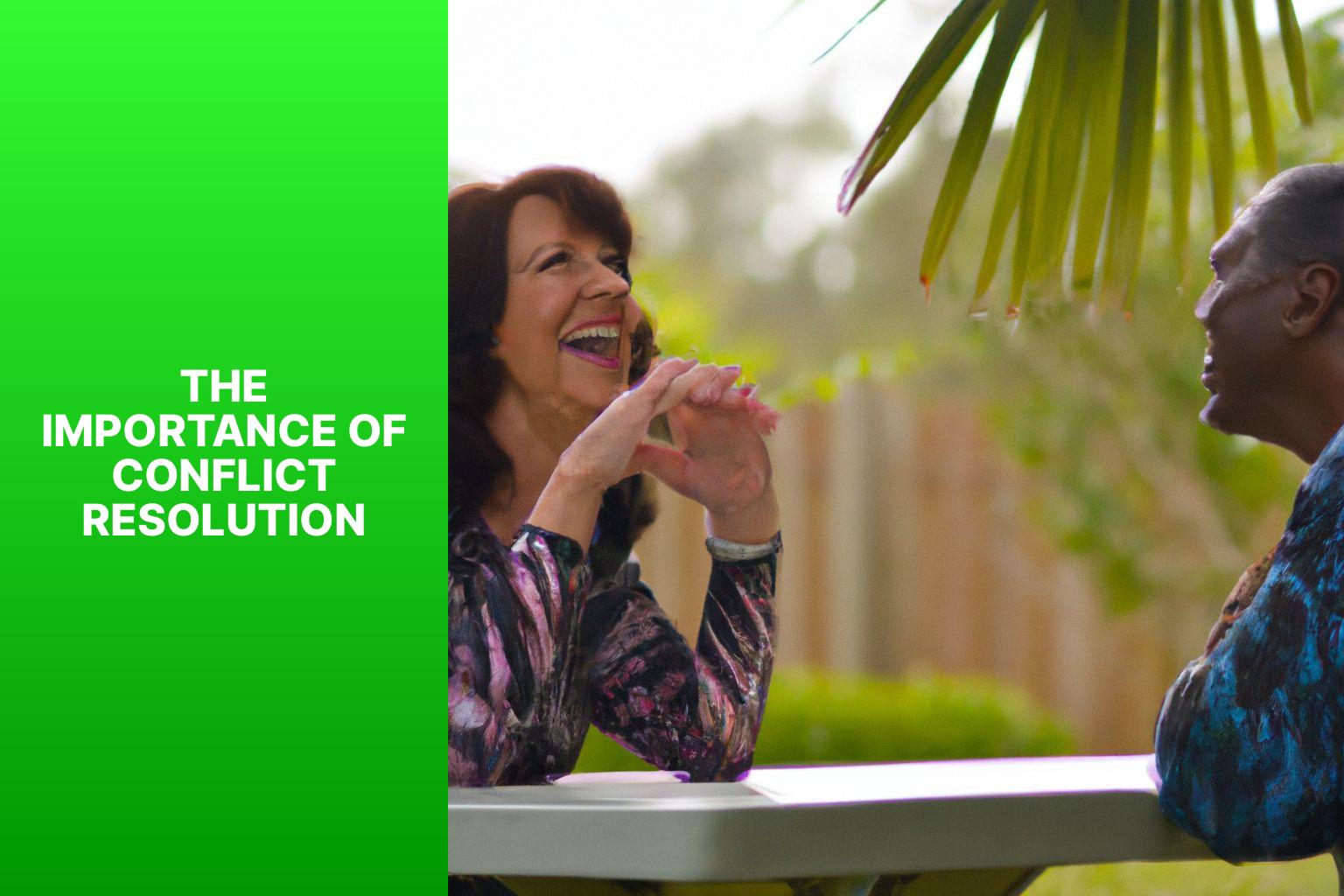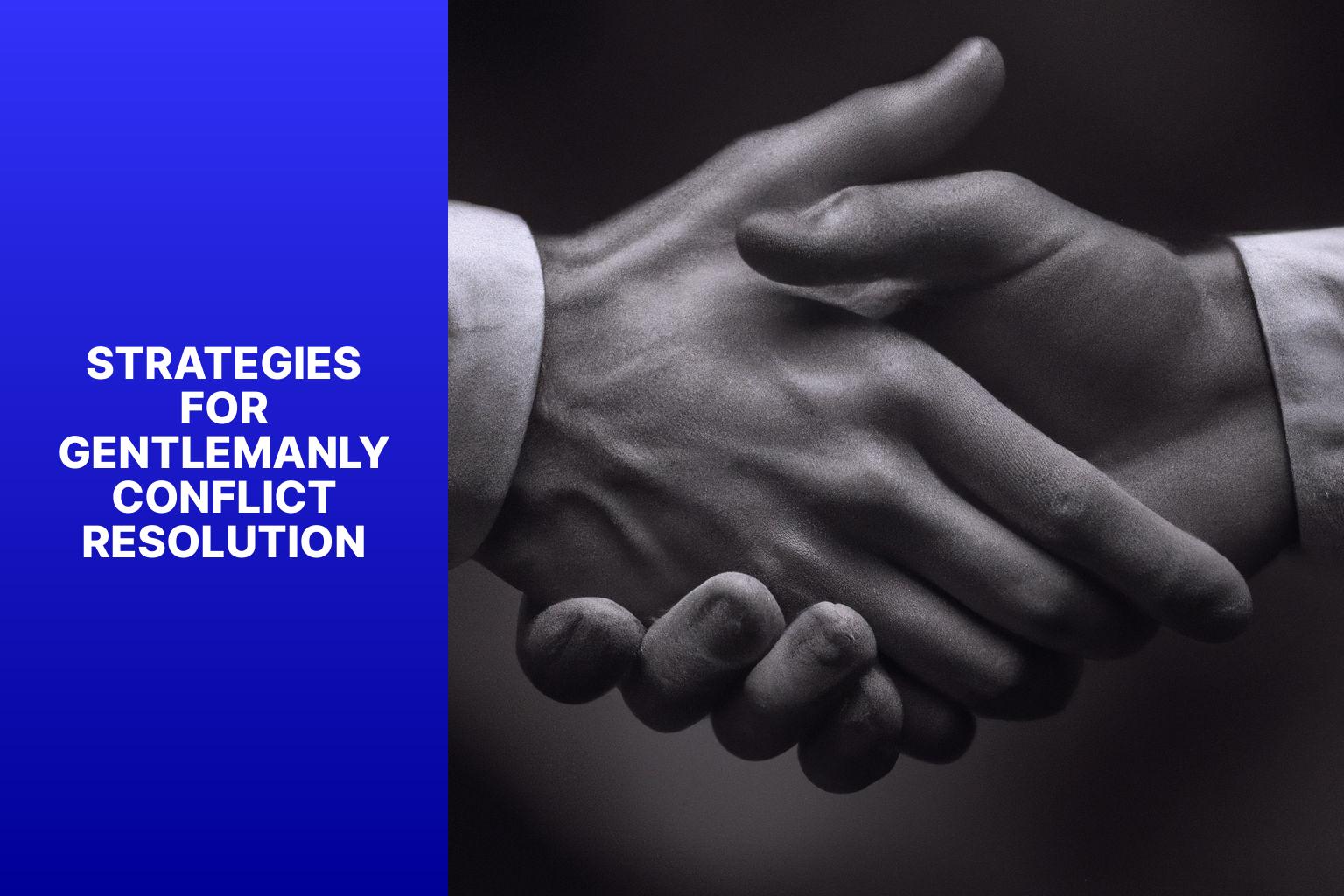Handling Conflict: A Gentleman’s Guide to Resolution
Conflict is an inevitable part of life, and how we handle it can greatly impact the quality of our relationships and overall well-being. In this gentleman’s guide to conflict resolution, we will explore the importance of effectively managing conflicts and provide strategies to navigate them gracefully. Understanding different conflict styles, such as avoidance, accommodation, competition, compromise, and collaboration, is essential in finding the most appropriate approach for each situation.
Effective communication techniques play a crucial role in resolving conflicts. Active listening, using “I” statements, empathy, seeking clarification, and understanding the significance of non-verbal communication can greatly contribute to finding common ground and fostering positive dialogue.

To resolve conflicts in a gentlemanly manner, strategies such as cooling down and reflecting, choosing the right time and place for discussions, approaching conflicts with respect and politeness, separating the person from the problem, and striving for win-win solutions are key.
Some conflicts may carry higher stakes and require additional measures. Seeking mediation or professional help, managing emotions and anger, and focusing on the long-term relationship rather than temporary satisfaction are essential when dealing with such situations.
By embracing these principles and approaches to conflict resolution, gentlemen can navigate conflicts with grace, empathy, and integrity, fostering healthier relationships and a more harmonious environment.
Key Takeaways
- Conflict resolution is important for maintaining healthy relationships and preventing further escalation.
- Understanding different conflict styles, such as avoidance, accommodation, competition, compromise, and collaboration, can help navigate conflicts effectively.
- Effective communication techniques, such as active listening, using “I” statements, empathy, seeking clarification, and non-verbal communication, can aid in resolving conflicts peacefully.
- Gentlemanly conflict resolution strategies involve calming down and reflecting, choosing the right time and place, approaching with respect and politeness, separating the person from the problem, and collaborating for win-win solutions.
- Dealing with high-stakes conflicts may require seeking mediation or professional help, managing emotions and anger, and prioritizing long-term relationships.
The Importance of Conflict Resolution

Photo Credits: Www.Moderngentlemanmagazine.Com by Russell Sanchez
Conflict resolution is an essential skill in every gentleman’s toolkit. In this section, we’ll uncover the reasons why conflict resolution holds such significance. We’ll dive into the various conflict styles, shedding light on how understanding them can pave the way towards effective resolution. So buckle up, and get ready to explore the art of conflict resolution like a true gentleman.
Understanding Different Conflict Styles
Understanding different conflict styles is vital for effective conflict resolution. Here are the various conflict styles:
1. Avoidance: Neglect or steer clear of conflicts altogether. This can be beneficial for minor issues or when emotions are too intense for a calm discussion.
2. Accommodation: Give priority to the needs of others over your own. It is effective for preserving relationships.
3. Competition: Assert your needs even if it comes at the expense of others. This approach is useful for making quick decisions or when someone is taking advantage of you.
4. Compromise: Seek a middle ground where both parties are willing to give up something to reach an agreement. This is advantageous when both parties are open to making concessions.
5. Collaboration: Work together to find a mutually beneficial resolution. Place emphasis on open communication, creativity, and understanding the needs of both parties.
By comprehending these conflict styles, you can adapt your approach to each situation and choose the most appropriate style for effectively resolving conflicts. Remember, the aim of conflict resolution is not always to “win,” but rather to discover a solution that satisfies the needs and interests of everyone involved.
Avoidance
Avoidance is a common conflict style that people use when they want to steer clear of conflict. This approach can have consequences that should be considered.
Avoiding conflicts can create unresolved issues, leading to resentment and tension in relationships. By avoiding conflicts, individuals miss opportunities for growth and change through open communication. Avoidance can perpetuate unhealthy power dynamics, with one party dominating the relationship and the other feeling silenced. Consistently avoiding conflicts prevents addressing core issues, making it difficult to find a resolution. Avoiding conflicts also hinders the development of conflict resolution skills, which are essential for managing personal and professional situations effectively.
While avoidance may seem tempting for maintaining peace and harmony, it is important to recognize that conflicts are a natural part of human interaction. Instead of avoiding conflicts, it is more beneficial to approach them with an open mind, staying calm, and engaging in active and effective communication.
Accommodation
Accommodation involves one party giving in to the needs or desires of the other party. It is important in maintaining relationships and harmony. The focus is on compromise, collaboration, and finding mutually beneficial solutions.
In accommodation, both parties need to communicate and listen to each other’s perspectives. Listening and understanding without interrupting or dismissing is crucial. Seeking clarification and asking questions can lead to a better understanding and resolution of conflicts.
Choosing the right time and place for the conversation is important in the accommodation process. Creating a comfortable and safe environment facilitates open and honest communication. It is essential to separate the person from the problem, focusing on the core issue instead of assigning blame or making personal attacks.
Staying calm and avoiding defensiveness is necessary in accommodation. Managing emotions and choosing the right words can lead to better communication. Exploring options for compromise and collaboration rather than using absolutes is important.
Competition

Photo Credits @iamrameestc
Competition plays a significant role in conflict resolution by fostering a healthy environment for individuals to express their views and strive for the best outcome. Individuals in a competitive scenario are motivated to present their ideas confidently and assertively. This active participation encourages critical thinking and allows for a comprehensive exploration of different perspectives.
In competition-based conflict resolution, individuals challenge each other’s ideas and strategies, identifying strengths and weaknesses in various approaches. This leads to a more effective solution. Competition also promotes accountability as individuals take ownership of their positions and work towards favorable outcomes.
It is important to focus on healthy competition rather than winning or overpowering the other party in this approach. The goal is to find a mutually beneficial resolution by considering all viewpoints and finding common ground.
Maintaining open and honest communication is vital when engaging in competition during conflict resolution. Active listening, seeking clarification, and using clear and precise language are essential for effective communication. Staying calm and composed is important to avoid hindrances from emotions.
By embracing competition as part of the conflict resolution process, individuals can generate innovative solutions, enhance critical thinking skills, and achieve mutually beneficial outcomes.
Compromise
Compromise is crucial for conflict resolution. Here are some key points:
- Identify the core issue: To reach a compromise, identify the underlying problem or disagreement.
- Stay open-minded: Consider different perspectives and solutions.
- Seek common ground: Look for areas of agreement between parties involved.
- Give and take: Both parties must make concessions to reach a resolution.
- Communicate openly: Express needs and understand the other party’s perspective.
Compromise is valuable in personal and professional situations. It allows individuals to maintain relationships, solve conflicts, and achieve mutually satisfactory outcomes. By embracing compromise, conflicts can be resolved in a fair and cooperative manner.
Collaboration
Collaboration is essential for conflict resolution. It promotes the pooling of ideas and efforts to find mutually beneficial solutions. Here are key points to consider for effective collaboration:
- Active participation: Each party should actively engage in the collaborative process. They should share their perspectives, concerns, and potential solutions.
- Open-mindedness: Being open to different viewpoints and ideas is crucial. It allows for exploration of various options and increases the likelihood of finding a satisfactory resolution.
- Effective communication: Communication plays a vital role. Express thoughts and feelings clearly and respectfully, ensuring everyone has a chance to contribute and be heard.
- Problem-solving orientation: Collaboration focuses on finding solutions rather than dwelling on the problem. It involves brainstorming and evaluating potential solutions together to reach a consensus.
- Flexibility: Collaboration often requires compromise and flexibility to accommodate diverse perspectives and needs. This may involve finding creative alternatives that address the interests of all parties.
- Building trust: Trust is crucial in collaborative environments. It is fostered through active listening, respect for differing opinions, and a commitment to working together towards a resolution.
- Commitment to the process: Collaborative conflict resolution requires a commitment from all parties to actively participate, contribute constructively, and invest the necessary time and effort to reach a resolution.
By adopting a collaborative approach, conflicts can be transformed into opportunities for understanding, growth, and improved relationships.
Effective Communication Techniques for Conflict Resolution

Photo Credits @canrevagency
Effective conflict resolution requires employing various communication techniques. In this section, we will explore several powerful tools for resolving conflicts in a gentlemanly manner. From active listening to using “I” statements, from empathy and understanding to seeking clarification, and not forgetting the impact of non-verbal cues, we will delve into these techniques to equip you with the skills needed to successfully navigate and defuse conflicts. Get ready to master the art of communication for conflict resolution.
Active Listening
Active listening is crucial for effective conflict resolution. It shows genuine interest and attentiveness to the other person’s thoughts and feelings. Here are key aspects of active listening:
- Give your full attention: Focus on the speaker and avoid distractions. Maintain eye contact, nod, and use non-verbal cues to show engagement.
- Be patient and avoid interruptions: Let the speaker express their thoughts without interruption. Give them the time they need to convey their message.
- Show empathy and understanding: Put yourself in the speaker’s shoes and try to understand their perspective. Empathize with their emotions and acknowledge their feelings.
- Paraphrase and summarize: Repeat what the speaker said in your own words to confirm understanding. Summarize their key points to demonstrate active listening.
- Avoid judgment and assumptions: Stay open-minded and avoid assumptions or jumping to conclusions. Seek clarification and ask questions to gain a deeper understanding.
Practicing active listening fosters better communication, builds trust, and creates a conducive environment for resolving conflicts. It allows both parties to feel heard and understood, leading to a mutually beneficial resolution.
Using “I” Statements
Using “I” statements is an effective technique for conflict resolution. It allows individuals to express their feelings and thoughts without blaming or attacking others.
1. Take ownership: When utilizing “I” statements, take ownership of your own feelings and thoughts. For instance, instead of stating “You always make me feel ignored,” say “I feel ignored when you don’t listen to me.”
2. Express emotions: Employ “I” statements to clearly and directly express your emotions. For example, say “I feel hurt when you make decisions without consulting me,” instead of saying “You never consider my opinions.”
3. Stay calm and respectful: It is crucial to maintain a calm and respectful tone when using “I” statements. This approach fosters open and honest conversation and reduces the chances of escalating the conflict.
4. Be specific: Clearly communicate the behavior or action that has caused your feelings. For instance, say “I feel overwhelmed when you leave all the household chores to me,” instead of saying “You never help me with anything.”
5. Focus on mutual understanding: The purpose of utilizing “I” statements is to promote understanding and find a mutually beneficial resolution. By expressing your perspective, you create an opportunity for change and better communication.
Using “I” statements enables individuals to express their emotions and concerns in a non-accusatory manner, promoting effective communication and providing a starting point for conflict resolution.
Empathy and Understanding
Empathy and understanding are crucial elements in effectively resolving conflicts. By incorporating empathy and understanding into our interactions, we can enhance communication and discover mutually beneficial resolutions.
Empathy enables us to establish a deep connection with others and truly comprehend their emotions. Through empathetic behavior, we create a supportive and safe environment where both parties feel acknowledged.
Understanding involves actively listening to the perspectives of others and making an effort to genuinely comprehend their thoughts and concerns. This process helps us uncover the root causes of conflicts.
When practicing empathy and understanding, it is essential to refrain from judgment and maintain an open-minded approach. Instead of assuming the intentions of the other person, we should seek clarification through asking questions.
Through sincere listening and demonstrating empathy, we can enhance communication and the dynamics between conflicting parties. This fosters a collaborative approach to conflict resolution and encourages growth and change. Empathy and understanding serve as the foundation for effective conflict resolution and the development of stronger relationships.
Seeking Clarification
Incorporating keywords naturally into the text:
Seeking clarification is a key step in conflict resolution. It is crucial for individuals to understand the situation and find a satisfactory resolution. To effectively seek clarification, it is important to ask open-ended questions and actively listen without interrupting. By doing so, misunderstandings can be prevented, and clear communication can be promoted. It is essential to choose respectful words and avoid using accusatory language when seeking clarification. Especially in high-stakes conflicts, it is important to remain calm and approach seeking clarification in a respectful manner. This will help to clear the air and ultimately improve communication.
Non-Verbal Communication
Non-verbal communication is crucial in conflict resolution. Here are key aspects to consider:
1. Body language: Facial expressions, gestures, and posture convey emotions and intentions. Maintaining eye contact shows attentiveness and interest, while crossed arms may indicate defensiveness or resistance.
2. Tone of voice: Speaking calmly and clearly can help de-escalate tension, while raising your voice or using aggressive tones can escalate the situation.
3. Use of space: Personal space impacts conflict resolution. Invading someone’s personal space can be seen as aggressive, while allowing for adequate space creates a comfortable environment for discussion.
4. Touch: Appropriate touch communicates empathy and support. A comforting pat on the back or a reassuring hand on the arm builds trust and establishes a connection. It is important to respect personal boundaries and cultural norms.
5. Facial expressions: Smiling indicates openness and friendliness, while frowning may convey displeasure or disagreement. Paying attention to these cues helps understand underlying emotions.
By effectively utilizing non-verbal communication, individuals can enhance understanding, build rapport, and facilitate positive conflict resolution. Remember to consider non-verbal cues alongside verbal communication for effective resolution.
Strategies for Gentlemanly Conflict Resolution

Photo Credits: Www.Moderngentlemanmagazine.Com by Robert Moore
Looking to handle conflicts like a true gentleman? In this section, we’ll uncover effective strategies for resolving conflicts with grace and dignity. From taking a step back to cool down and reflect, to approaching the situation with respect and politeness, we’ll explore practical techniques that can lead to mutually beneficial outcomes. Learn how to choose the right time and place, separate the person from the problem, and collaborate to find win-win solutions. Get ready to navigate the rough waters of conflict resolution with finesse!
Cool Down and Reflect
Cooling down and reflecting is essential in conflict resolution. To effectively resolve conflicts, it is important to calm our emotions and engage in self-reflection. Here are key points to consider when cooling down and reflecting:
1. Step back: When conflicts arise, remove yourself temporarily. Gain perspective and distance from intense emotions.
2. Breathe and relax: Deep breathing reduces stress and promotes relaxation. Focus on your breath to calm your mind and prepare for the next steps.
3. Reflect on the situation: During this cooling down period, consider the core issues at hand. What caused the conflict? How did you contribute? Reflect to understand the conflict and your role.
4. Consider different perspectives: Cooling down and reflecting allows you to consider different perspectives. Develop empathy and understanding for the other person involved. Approach the resolution with an open mind.
5. Plan your response: After cooling down and reflecting, it’s important to plan your response. Think about the most effective way to communicate your thoughts and feelings. Choose words carefully and avoid confrontation for a more positive and productive conversation.
Remember, cooling down and reflecting is vital in conflict resolution. By calming yourself and reflecting on the situation, you can approach the resolution process with a clear mind and increase the likelihood of achieving a mutually beneficial outcome.
Choose the Right Time and Place
Choosing the right time and place is crucial for resolving conflicts effectively. Here are some important considerations to keep in mind:
1. Privacy: Find a quiet, private location where you can have uninterrupted conversations. This will allow both parties to comfortably express their thoughts and emotions.
2. Neutral Environment: Select a setting that is neutral and unbiased to ensure neither party feels disadvantaged or threatened. This can help create a more constructive and open atmosphere for resolving conflicts.
3. Timing: Choose a time when both parties are calm and open-minded. Avoid discussing the conflict when either party is stressed, tired, or preoccupied. It’s important to have a clear mind and be emotionally ready to engage in the conversation.
4. Consideration for Others: If multiple people are involved in the conflict, find a time and place that is convenient for everyone. This will create an inclusive and fair environment for all parties to express their perspectives.
5. Comfort Level: Take into account the comfort level of each individual. For some people, discussing conflicts in person may be uncomfortable or intimidating. In such cases, consider alternative forms of communication, such as writing a letter or having a mediated conversation.
By carefully choosing the right time and place for conflict resolution, you can increase the chances of having a productive and successful conversation.
Approach with Respect and Politeness
Approaching conflicts with respect and politeness is crucial for effective resolution and maintaining positive relationships. It sets the tone for open and honest communication, creating an environment where both parties feel heard and valued. Here are some key points to consider when approaching conflicts:
1. Use respectful language: Choose your words carefully and avoid aggressive or derogatory language. Being courteous and respectful in your choice of words can prevent escalation and create a receptive atmosphere.
2. Practice active listening: Show genuine interest in the other person’s perspective and actively listen to what they have to say. Avoid interrupting or dismissing their thoughts and feelings. Giving them your full attention demonstrates respect and helps build understanding.
3. Seek common ground: Look for areas of agreement or shared values to find common ground. Acknowledging and respecting each other’s viewpoints can help bridge the gap and find mutually beneficial solutions.
4. Be mindful of body language: Non-verbal cues such as eye contact, facial expressions, and posture can convey respect or disrespect. Maintain open and attentive body language to show that you are engaged and respectful.
5. Take responsibility for your actions: Acknowledge your role in the conflict and apologize if necessary. Taking responsibility shows humility and respect for the other person’s feelings.
6. Stay calm and composed: Maintaining a calm demeanor can help diffuse tension and prevent the situation from escalating. Take deep breaths and avoid reacting impulsively or aggressively.
Approaching conflicts with respect and politeness creates an opportunity for constructive dialogue and ultimately leads to a more positive and peaceful resolution. By fostering an atmosphere of mutual respect, conflicts can be managed more effectively and relationships can be strengthened.
Separate the Person from the Problem
Separating the person from the problem is crucial for effective conflict resolution. It ensures that the focus remains on finding a solution rather than attacking or blaming individuals. By separating the person from the problem, a more objective and rational approach to resolving conflicts is possible.
Instead of targeting individuals, it is important to address the core issue at hand. By identifying the underlying problem, both parties can collaborate towards a mutually beneficial resolution. This approach encourages open and honest conversation, where each person can freely express their thoughts and feelings without the fear of being attacked or judged.
When separating the person from the problem, it is essential to choose the appropriate words and avoid using absolute statements that may escalate the conflict. Staying calm and avoiding emotional reactions is also crucial. By maintaining composure, it becomes easier to genuinely listen to the other person’s perspective and understand their point of view.
Separating the person from the problem also entails avoiding victim-blaming or personal attacks. Instead, it is better to focus on presenting the facts and evidence when discussing the issue. This approach creates an opportunity for change and promotes better communication, as it redirects the focus towards resolving the conflict rather than assigning blame.
Collaborate for Win-Win Solutions

Photo Credits @canrevagency
Collaborating for win-win solutions is the most effective approach to conflict resolution. Here are key strategies to consider:
1. Identify common goals: Start by finding common ground and aligning on the desired outcome. This creates a shared understanding and sets the foundation for collaboration.
2. Foster open communication: Encourage all parties to share their perspectives, concerns, and ideas. This builds trust and creates an environment for meaningful collaboration.
3. Practice active listening: Seek to understand the underlying needs and interests of all parties. Give each person the opportunity to express themselves without interruption or judgment.
4. Engage in brainstorming: Collaboratively generate a variety of possible solutions. Encourage creativity and explore different perspectives and options.
5. Seek win-win solutions: Address core issues and meet the needs and interests of all parties. Strive for solutions that enable everyone to achieve their goals and feel satisfied.
6. Be flexible and open to compromise: Recognize that a mutually beneficial resolution may require compromise. Explore different options and be flexible in thinking.
7. Maintain a positive mindset: Focus on finding solutions rather than dwelling on the conflict. Create a constructive atmosphere for problem-solving.
8. Follow through: Ensure all parties fulfill their commitments once a win-win solution is agreed upon. Effective implementation and ongoing communication are vital for success.
By collaborating for win-win solutions, you can foster shared ownership and create outcomes that benefit everyone involved. It promotes effective communication, respect, and finding common ground.
Dealing with High-Stakes Conflicts
In the realm of conflict resolution, navigating high-stakes conflicts can be quite the challenge. But fear not, because in this section, we’ll dive into effective strategies that can help you successfully navigate these intense situations. From seeking mediation or professional help to managing your emotions and anger, and even focusing on fostering long-term relationships, we’ve got you covered with powerful insights and techniques. So, brace yourself for a journey toward smoother resolutions and healthier connections.
Seeking Mediation or Professional Help
When resolving conflicts, it may be necessary to seek mediation or professional help. Consider utilizing the following options:
– Mediation: Engage a neutral third party to facilitate communication and negotiation between conflicting parties. A trained mediator can guide the conversation and explore solutions, particularly for complex issues or when emotions are running high.
– Counseling or therapy: Seek the assistance of a professional counselor or therapist to create a safe space for discussing and working through conflicts. Gain insight into emotions and behaviors, enhance communication skills, and develop strategies for healthy conflict resolution.
– Conflict resolution coaching: Acquire skills and strategies for navigating difficult situations. A conflict resolution coach provides guidance, support, and accountability to resolve conflicts and enhance relationships.
– Legal assistance: In certain instances, conflicts may involve legal matters or necessitate the involvement of an attorney. Seek the aid of a lawyer to understand rights, navigate the legal system, and work towards a fair and equitable resolution.
Remember that seeking mediation or professional help does not indicate weakness, but rather a proactive step towards finding a mutually beneficial resolution. These professionals possess the expertise and experience to guide individuals through challenging situations and assist in achieving fair and satisfactory resolutions for all parties involved.
Managing Emotions and Anger
Managing Emotions and Anger is crucial for conflict resolution. It is essential to address and manage these intense emotions to reach a satisfactory resolution. Here are effective strategies for managing emotions and anger during conflicts:
- Stay calm: Keep emotions in check and remain calm during a conflict. Take deep breaths and control anger or frustration.
- Practice active listening: Listen attentively to the other person’s perspective without interrupting or getting defensive. This shows respect and allows for a better understanding of their emotions.
- Use “I” statements: Express feelings and concerns using “I” statements, such as “I feel upset when…” or “I am frustrated because…”. This helps communicate emotions without blaming the other person.
- Seek clarification: If unsure about something the other person said or did, ask for clarification. This can prevent misunderstandings and defuse escalating emotions.
- Empathize and understand: Try to understand the other person’s emotions by putting yourself in their shoes. Empathy helps create a connection and fosters cooperation.
- Choose the right words: Use constructive and respectful language when expressing emotions. Avoid using offensive or aggressive words that can escalate the conflict.
- Take a break if needed: If the conversation becomes too heated or emotions are overwhelming, suggest taking a break. Stepping away temporarily can help regain composure and approach the conflict with a fresh perspective.
Remember, managing emotions and anger is crucial for productive conflict resolution. By employing these strategies, you can promote understanding and work towards a mutually beneficial resolution.
Focusing on Long-Term Relationships
Focusing on long-term relationships is paramount for conflict resolution. It entails recognizing that resolving conflicts is not merely about finding a quick fix, but also about fostering positive and enduring relationships. Here are key strategies to concentrate on long-term relationships while resolving conflicts:
1. Foster open and honest communication: Encourage open dialogue and active listening to establish trust and comprehension among the involved parties. This lays the groundwork for resolving conflicts in a healthy manner.
2. Choose the right time and place: Select an appropriate environment for addressing conflicts. Opt for a neutral space where both parties feel comfortable and secure in expressing their thoughts and emotions.
3. Approach with respect and politeness: Treat the other person with respect, even in the midst of a conflict, to prevent further escalation. Employ respectful language and maintain a calm demeanor to contribute to a more constructive discussion.
4. Collaborate for win-win solutions: Strive to find solutions that benefit both parties, rather than focusing solely on one individual’s needs. This approach ensures that everyone feels valued and that their interests are taken into consideration.
5. Manage conflict with a long-term perspective: Avoid absolutes and blaming the victim. Address the core issues and concentrate on understanding each other’s perspectives to effectively resolve conflicts and strengthen relationships.
By incorporating these strategies into the conflict resolution process, individuals can resolve conflicts, nurture healthy relationships, and promote growth and positive change. This leads to stronger connections and more harmonious interactions.
Frequently Asked Questions
Why is it important to address conflicts rather than avoid them?
Avoiding confrontation only amplifies problems and negative feelings. By addressing conflicts directly, you have the opportunity to find a resolution and improve the situation. Ignoring conflicts can lead to further misunderstandings and resentment.
How can I handle a confrontation assertively and kindly?
Choosing the right words is crucial in handling a confrontation. Be mindful of using “I” statements to express how the confrontation makes you feel. Balancing assertiveness and kindness allows you to communicate your perspective effectively while respecting the other person’s feelings.
Should conflicts be addressed in person or through written communication?
It is recommended to address conflicts in person or over the phone, rather than through text or email. Face-to-face communication allows for better understanding of non-verbal cues and promotes a more open and honest conversation.
How can I stay calm and composed during a confrontation?
Staying calm and composed is essential, even if the other person is angry. Take deep breaths, listen actively, and remind yourself to respond rather than react. This will help create an environment conducive to resolving the conflict.
What is the benefit of addressing one issue at a time in conflicts?
Addressing one issue at a time is more effective in resolving conflicts because it allows you to focus on specific concerns and find solutions. Tackling multiple issues simultaneously can lead to confusion and make it challenging to reach a resolution.
How can I maintain positive relationships after resolving a conflict?
Forgiveness plays a vital role in maintaining positive relationships. After resolving a conflict, it is important to let go of grudges and move forward. Focusing on building positive relationships through open communication, empathy, and understanding can help prevent future conflicts.
